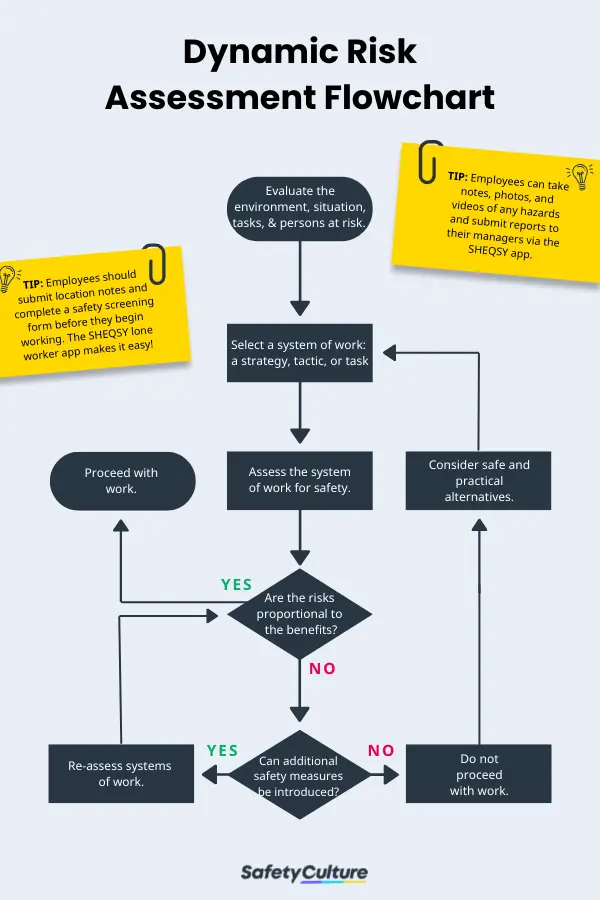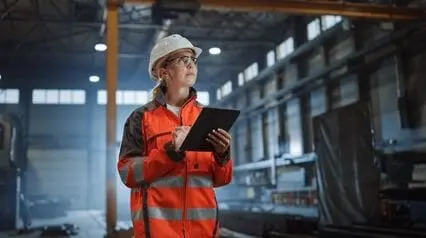What is a Dynamic Risk Assessment?
A dynamic risk assessment (DRA) is a continuous safety practice that allows workers to quickly identify hazards ‘on the spot’, remove them, and proceed with work safely. DRAs are performed by regularly observing and analyzing high-risk or changing work environments and making quick, yet considered decisions.
Though it is an employer’s responsibility to keep their lone workers safe, employees should also feel empowered to make informed decisions to protect themselves, other employees, and their organizations. Dynamic risk assessments are one of the key practices that employees can use to accomplish this – especially in lone-working, high-risk, or frequently changing environments.
A dynamic risk assessment is sometimes also referred to as a dynamic operational risk assessment.
When Should a Dynamic Risk Assessment Be Completed?
Employees who work alone, in high-risk environments, or in regularly changing environments should complete dynamic risk assessments frequently, whenever they need to quickly observe and analyze the safety risks and hazards specific to their evolving circumstances.
Emergency service providers, security guards, factory workers, and in-home healthcare providers are examples of employees who should assess risks frequently.
Regular observations and assessments of your environment are necessary to predict unforeseen events. A dynamic risk assessment also helps when risks and hazards arise from the following circumstances:
- Introduction of new equipment/resources
- Change of supervision approach
- Opening a new line of business
- Reallocation of work
- When there are threats to safety and security
Dynamic Risk Assessment Flowchart
The Dynamic Risk Assessment Flowchart below outlines the simple steps employees should take to assess risks and hazards and make decisions to mitigate them.
The basic steps include:
- Evaluating the environment, situation, tasks, and persons at risk
- Identifying the risk type, severity, and likelihood of an incident
- Selecting a system of work: a strategy, tactic, or task
- Assessing the system of work for safety
- Considering if the risks are proportional to the benefits
- Proceeding with work or delaying the work until additional safety measures can be introduced and a safe system of work is possible

What is the Difference Between a Risk Assessment and a Dynamic Risk Assessment?
A risk assessment is conducted when there’s a new process or new equipment in the workplace in order to determine risks and proactively come up with safety measures before the implementation of the new process or use of the new equipment. A dynamic risk assessment on the other hand is more spontaneous, especially in high-risk environments where it is conducted on the spot when there’s a sudden change in the situation and risks need to be immediately identified and controlled.
Why Should Organizations Complete Risk Assessments?
The reasons for carrying out risk assessments are simple.
The main objective is to help keep employees, other people, and property out of harm’s way. After all, according to OSHA, “one of the ‘root causes’ of workplace injuries, illnesses, and incidents is the failure to identify or recognize hazards that are present, or that could have been anticipated” (1).
Carrying out risk assessments can also reduce an organization’s financial exposure to workers’ compensation claims and property damage.
Why Perform Dynamic Risk Assessments
Dynamic risks are those that are difficult to predict and can result from organizational and environmental changes, e.g., slip hazards caused by bad weather or physical danger from visiting someone’s home. While conducting a dynamic risk assessment is not a legal requirement, HSE recommends it as it promotes safety. Manual handling and lone workers pose a higher dynamic risk due to the nature of their work. Performing dynamic risk assessments can help businesses identify, connect, and visualize critical risk clusters present in the workplace. This can help reduce the risk of workplace accidents and injuries caused by difficult-to-predict hazards.
Workers that conduct dynamic risk assessments can experience other benefits such as:
- Increase in risk awareness
- Decrease in the likelihood of incidents
- Learn quick thinking
- Being better at reading situations and making decisions
- Applying the correct actions
What Types of Risk Assessments Should Organizations Complete?
Of course, organizations should encourage their employees to regularly complete dynamic risk assessments as they work, according to a predetermined set of steps, such as in the Dynamic Risk Assessment Flowchart above. They can also deploy a safety solution, like SHEQSY by SafetyCulture, to allow employees to do so.
In addition, organizations should carry out formal risk assessments. These assessments are performed in advance, recorded, and revisited on a regular basis, and are often informed by current circumstances, information from relevant employees familiar with the day-to-day risks of carrying out specific activities in these environments, and historical data.
Create Your Own Dynamic Risk Assessment Checklist
Eliminate manual tasks and streamline your operations.
Get started for FREEWho Should Carry Out Formal Risk Assessments?
It is the employer’s responsibility to keep their employees safe, and therefore, their duty to carry out formal risk assessments; however, the employer can also appoint an employee with the relevant knowledge, experience, and skills to complete the formal assessment.
Relevant managers and employees should be involved in the process so that they can share their experiences. One of the simplest ways to accomplish this is by giving employees the proper tools to complete and share the results of their dynamic risk assessments. This ensures that formal risk assessments are as thorough as possible.
Employers and managers should also train their employees on the proper risk assessment procedures, however. Using a Learning Management System (LMS) like SafetyCulture (formerly iAuditor)’s Training, employers can ensure that a culture of safety will be prevalent from all around.
Example of a Dynamic Risk Assessment
Consider a nurse who carries out visits inside patients’ homes.
Each patient and each home the nurse visits will be different, and there will always be risks that a formal risk assessment cannot predict. Therefore, conducting a dynamic risk assessment is necessary to identify any hazards that may arise and to develop controls to reduce or eliminate the risks.
Imagine this: One afternoon, the nurse visits a patient. Upon entering the home, the nurse starts feeling uncertain about her safety. She looks around to identify and assess the risks, and she notices warning signs – empty glass bottles, pill bottles, and strong smells. She also hears voices coming from another room and understands that she and the patient are not alone. She becomes aware that the client, or the people in the other room, may be under the influence of drugs and alcohol.
Next, she considers what she knows about the patient, the situation, and the environment, and asks herself questions such as:
- Does the patient have a history of alcohol and drug abuse? Do they have a history of violence? How could these substances affect their mood? Might the patient behave erratically?
- Who else is here other than the patient? Have they been using?
- Do I feel safe? Do I feel confident? Am I prepared? Is there anyone else around who is at risk? Is this situation likely to lead to an incident?
- Am I vulnerable in any way? Is there a weapon here that could be used against me? Do I have a way to call for help? Is there an excuse I can make to leave? Where are the exits? Does my manager know where I am?
- Are my words or actions making the situation worse? Does the patient want me to be here? Am I invading their space?
Asking questions like these helps the nurse assess the situation and decide whether or not she should proceed with her work, how she can proceed safely, and how she could call for help and/or leave in the event of an emergency.
This case study details how Epworth HealthCare safeguards lone healthcare workers with SHEQSY and improves management processes.



